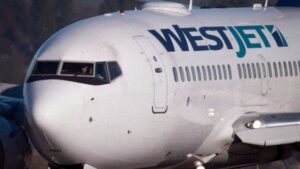
An Edmonton-bound WestJet flight from London, England, has landed safely in Iceland after being diverted due to a “potential mechanical issue,” the airline said Saturday.
The flight, number WS27, left London’s Gatwick airport at around 11:45 a.m. local time after a delay, and was scheduled to arrive in Edmonton just before 1 p.m.

Pilots reported an emergency just over two hours into the flight, and the Boeing 767 was thought to be dumping fuel as it circled over the Atlantic Ocean near Keflavik International Airport, near Reykjavik, Iceland.
WestJet spokeswoman Lauren Stewart said the plane’s crew detected a “potential mechanical issue,” but did not specify what that issue was.
The captain told us through the PA that the engine had a malfunction of some sort, and that we had to make an emergency landing within the next 10 minutes
– Abdisalam Abdillahi, passenger
The flight landed safely at Keflavik International Airport at around 8:45 a.m. MT.
In an email, Stewart said the declaration of an emergency does not necessarily mean an “actual emergency” has occurred on board the flight.
“It is declared to establish priority landing and to ensure the availability of emergency vehicles whether needed or not, and is a measure taken out of an abundance of caution,” Stewart said.
Gudni Sigurdsson, a spokesman from Isavia, the national airport and air navigation service provider in Iceland, said the WestJet aircraft had “reduced power from one engine.” The captain of the flight decided to land in Iceland “for security reasons,” he said in an email.
“The aircraft circled for some time to burn fuel before landing and then landed safely. There were 258 passengers on board the aircraft.”
‘I thought it was just turbulence’
In a message to CBC, passenger Abdisalam Abdillahi said passengers heard a “big bang” about an hour into the flight.
“I thought it was just turbulence, but the captain told us through the PA that the engine had a malfunction of some sort, and that we had to make an emergency landing within the next 10 minutes,” he said.
“Some people slept through it and there wasn’t that much of a reaction. But the people [who] were by the wing definitely heard it.”
Abdillahi said the pilot then told passengers the plane needed to burn fuel and wouldn’t land for another hour.
He said passengers are being told they will have to wait until tomorrow to board another flight.
Passenger Dan Hayden said the flight was “very busy” but not quite sold out, and that passengers are waiting to hear more on what will happen next.
WestJet said the aircraft will remain in Iceland for maintenance.
Passenger Autumn Hodgins said the pilot and flight attendants were calm and reassuring as the flight diverted to Iceland.
WestJet bought the stranded travellers dinner and set them up in hotels, she said later Saturday afternoon.
Hodgins said WestJet has been “fantastic” in coordinating a team to take care of the passengers, but said she’s not sure if she’d fly internationally with the airline again.
ADVERTISEMENT
“The most important part here is that everyone is safe and everyone is OK,” she said.
WestJet’s London flights prompt complaints, compensation
WestJet’s service to London has been subject to a wave of complaints since it launched in May 2016.
It’s the first overseas destination for the four wide-bodied Boeing 767 jets that it bought from Qantas. The jets have an average age of 24 years, and began having mechanical problems.
In a video posted to WestJet’s internal YouTube channel on June 16, 2016, chief executive officer Gregg Saretsky explained the problem, calling the route a “hobbled operation.”
“The 767s have been giving us lots of grief, lots of mechanical problems,” said Saretsky in the video.
“We’re finding that when things break, because some of the parts are so old, we don’t have them in store. And then we’re doing a global search through the AOG desk to find them and then it’s taking two or three days to get these things. We don’t want to keep them in stock because they break once every 20 years.”